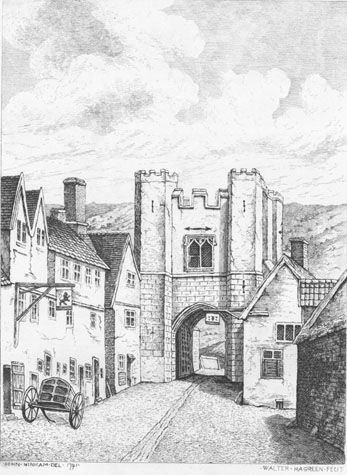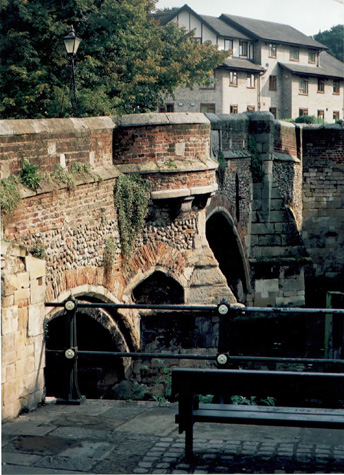|

[2] View of the bridge from the east about 1720 engraved by Henry Ninham
from the drawing by John Kirkpatrick [Norwich Castle Museum and Art
Gallery 1954.138, Todd 5, Norwich, 110a]

[3] View of the inside of the gateway about 1720 engraved by Henry Ninham
from the drawing by John Kirkpatrick [Norwich Castle Museum and Art
Gallery 1954.138, Todd 5, Norwich, 110b]

[4] View of the bridge from the east in 1791 by John Ninham published by
Fitch in 1861.

[5] View of the inside of the gateway in 1791 by John Ninham published by
Fitch.

[6] View looking east, out from the city over the bridge.

[7] View over the bridge looking towards the city. The spire in the
distance is the spire of the Cathedral giving some indication of the large
area enclosed within the defences.

[8] The south side of the bridge from the south west. The gate was set over
the nearest arch.

[9] The south side of the bridge.

[10] The south side of the bridge.
|
Documentary evidence
According to Fitch, this bridge and gate are so called because they gave entrance to the palace of the Bishop. The gate was built and repaired by the Prelates of the See until 1393, from whence it belonged to the city.
[Fitch, page 34]
In 1460 the wickets at Bishop Gate were kept by one soldier to let people in and out.
[Blomefield, page 1460] In 1451 and 1481 the ancient assessment for repairs
(The Agistment for Walls) showed that Middle-Wymer ward was responsible for repairs to the gate.
[Liber Albus, f. 177; Hudson & Tingey, vol. II, pages 313-15] However, individuals left money for the repair or upkeep of the defences. Five years after the death of Alderman John Gilbert in 1467, his executers agreed to pay �50 for the repair of Bishop's Bridge and the river banks.
[Hudson and Tingey, 1910 page cvii] In 1486 two oaken posts were fixed at the east end of Bishop's Bridge to mark the boundaries of the city's liberties.
[Blomefield, page 176]
During Kett's rebellion of 1549, the gates were attacked by the rebels, even though they were rampired with earth, and the rebels pulled the bars off the gates and entered the city. These gates were then burned by the rebels, and Kett's gunners battered the gate with cannon balls, and a great part of the wall and tower of the gate were demolished.
[Blomefield, page 250] The gate was repaired with wood from White Friars Bridge after the rebellion, and 'the tower at Bishopgate, and the stonework of all of them [the city gates] was repaired.
[Blomefield, page 259]
The Tonnage Books record that the gate and bridge were to be surveyed in 1790, and this done, it was discovered the first and the centre arches were damaged by the weight of both the gateway and the buttresses. The first arch was found to have a large fissure, and the foundations needed repair. The whole structure was found to lean to the north, and although settlement cracks had been secured with 'iron anchors' they were in fact again opened. It was pointed out that the arch of the gate was just 9 feet (2.75 metres) wide and this impeded the passage of loaded carts. The gate was removed, and only the bridge repaired, as noted by the Tonnage Book in 1791.
[N.R.O. NCR Case 19 Shelf C; Fitch, pages 53-6]
Early 18th-century pen and ink sketch of the gate and bridge by John Kirkpatrick
[NCM 1691.76.94] show part of the gate and towers, with houses adjoining to the left.
[2] The towers appear complete with battlements, and there appear to be no ruins. His depiction of the bridge and gate from the inside in 1720,
[copied by Henry Ninham in 1864 NCM Todd Collection, vol. II, box 5, p. 116g] shows the gate with its four turrets, with a relatively ornate mullioned window lighting the chamber over the arch.
[3] There are buildings abutting to the north and south. The view by Henry Ninham of the east or exterior side of the gate with the bridge was produced in 1864 but was based in Kirkpatrick's drawing of about 1720. It shows high parapet walls on either side of the gate forming a barbican.
[Norwich Castle Museum 1954.138, Todd 5, Norwich, 116C]
John Ninham's drawings of the gate in 1792, [4 & 5] published by Fitch in 1861, shows, on the inside, that the lower part was probably built in ashlar. There was a string and an offset just below the sill of the window of the chamber over the gate and the walling above the string is shown as either being rendered or as flint work. There is an iron tie or brace to the middle top centre of the gate above the window and fissures on the south west turret reflect the poor state of repair suggested by the report of 1790.
[NCM Fitch Collection 1778.76.94] From the outside, the view shows that the high parapets on either side of the bridge, shown on the drawings at the beginning of the century, had been removed. Again there is a brace shown to the top of the gate.
[NCM Fitch Collection 1777.76.94]
The piers and arches of the bridge survive in good condition and substantial corbells on the west piers on both sides show where the outer face of the gate and its outer turrets were supported.
[6, 7, 8, 9 & 10]
BIBLIOGRAPHY:
Blomefield, Francis, An Essay Towards the Topographical History of the
County of Norfolk, vol. III: The History and County of Norwich Part I
(London: W. Bulmer, 1806)
Collins, Arthur E., The Walls of Norwich (City and County of Norwich,
Norwich: Jarrold & Sons, 1910)
Fitch, Robert, Views of the Gates of Norwich made in the years 1792-3 by
the LateJohn Ninham (Norwich: Cundall, Miller, and Leavins, 1861)
Hudson, William, and Tingey, John C., The Records of the City of Norwich,
vol. II (Norwich & London: Jarrold & Sons, 1910)
See also:
Buckler, J., 'Bishop's Gate and Castle, Norwich', NCM 1941.12.9:INT
Hodgson, David, 'Bishop's Bridge and Gate', NCM 1898.41.73 (Sketch
Book, vol. I)
Hodgson, David, 'Bishop's Gate', NCM 1898.41.321 (Sketch Book, vol. II)
Pevsner, Nikolaus, North-east Norfolk and Norwich 1962 and 1979
Pococke, Edward, 'Sixteen Drawings of the Gates of Norwich', NCM
1955.219:INT
Thirtle, John, 'Bishop Gate Bridge and Cow Tower, Norwich', NCM
1951.235.1291.B1:INT
DOCUMENTARY REFERENCES:
N.R.O. MF/RO 29/3 f. 177 (Liber Albus)
N.R.O. NCR Case 19 Shelf C (Tonnage Books, 1720-1836)
HISTORIC VIEWS IN THE DATABASE:
From the Norwich Castle Museum and Art Gallery:
Kirkpatrick, John, c. 1720, 'Bishop Bridge and Towers and Houses
Adjoining', NCM Fitch Collection 1691.76.94
Ninham, Henry, 1864, from John Kirkpatrick, 1720, 'Bishopgate', NCM
Todd Collection, vol. II, box 5, p. 116c
Ninham, John, 1792, 'Bishop Gate, Inside', NCM Fitch Collection
1778.76.94
Ninham, John, 1792, 'Bishop Gate, Outside, NCM Fitch Collection
1777.76.94
|
